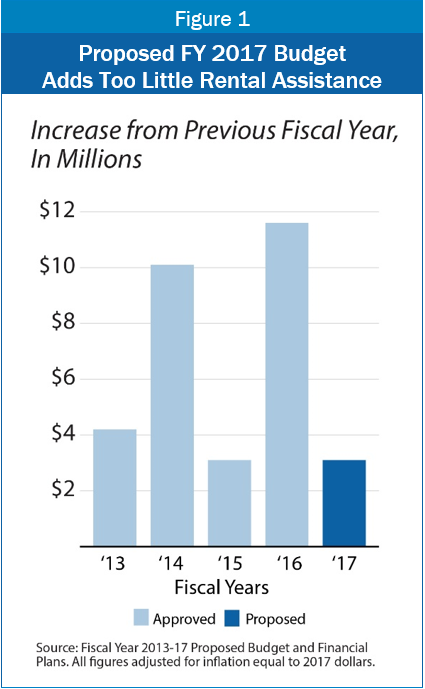Mayor Bowser’s proposed fiscal year (FY) 2017 budget maintains the important $100 million investment in the Housing Production Trust Fund, yet adds only a small amount of new funding for rental assistance that helps DC’s poorest households. This would make it hard for the Trust Fund to create housing affordable to such households, and will not make any progress toward helping the thousands of families on the DC Housing Authority waiting list.

The Local Rent Supplement Program (LRSP) provides ongoing rental assistance that pays the difference between what extremely low income families can afford and the actual cost of housing. Because LRSP bases rental subsidies on a household’s income, it is DC’s most effective housing tool to meet the needs of extremely low income families. These households — with incomes below 30 percent of the area median, or $32,800 for a family of four — are the most likely to face severe housing cost burdens.
The Mayor’s budget includes a $3 million increase in rental assistance to help 200 households, only one-fourth of the amount added in FY 2016. All of the increase is for the “targeted affordable housing” program for formerly homeless residents.
While this is an important investment, the FY 2017 budget fails to support new rental assistance that is critical to meet other needs:
- No new help for families on the housing waits list: LRSP rent vouchers are needed to help move some of the 41,000 families on the DC Housing Authority waiting list into affordable homes. The budget provides no resources to do this, however.
- No funds to help the Housing Production Trust Fund meet its low-income targeting: The Mayor’s budget also adds no new funds for rental assistance linked to units assisted by the Housing Production Trust Fund (HPTF). Without new LRSP for this purpose, it is not clear whether the Trust Fund will be able to meet its requirement to spend 40 percent of its resources on housing for extremely low income families. This is because the HPTF provides up-front financing assistance which does not help cover ongoing operating and maintenance costs. The lack of new project-based LRSP until 2014 is a large part of why the Trust Fund missed the 40 percent target in 2014 and 2015, when only 13 percent of dollars assisted housing for extremely low income residents.[1]
The modest increase in rental assistance means that the proposed FY 2017 budget makes only a small dent in meeting the needs of the 30,000 families at that income level who pay the majority of their income to keep a roof overhead.[2] Even if the Trust Fund is able to meet its low-income targeting, it will produce or preserve about 400 homes for extremely low income residents with this year’s funding, in addition to the 200 targeted affordable housing subsidies.
To address the large scale of need among the city’s poorest residents, the city needs to elevate rental assistance — through LRSP — to be at the center of its affordable housing strategy alongside the Trust Fund. Expanding project-based LRSP will help the $100 million investment in the Trust Fund reach the poorest families. And expanding tenant-based LRSP will help meet the urgent needs of families waiting for affordable housing.
To print a copy of today’s blog, click here.
[1] Department of Housing and Community Development, Performance Oversight Documents, 2015.
[2] DCFPI analysis of 2014 American Community Survey.
